Finance Assignment: Revenue Budget, Cash Budget, Variance Analysis
VerifiedAdded on 2023/01/16
|13
|1671
|90
Homework Assignment
AI Summary
This document presents a comprehensive solution to a finance assignment, addressing various aspects of financial analysis and management accounting. The solution begins with the preparation of a revenue budget for Clear Ltd, a company that bottles and distributes mineral water, considering bot...
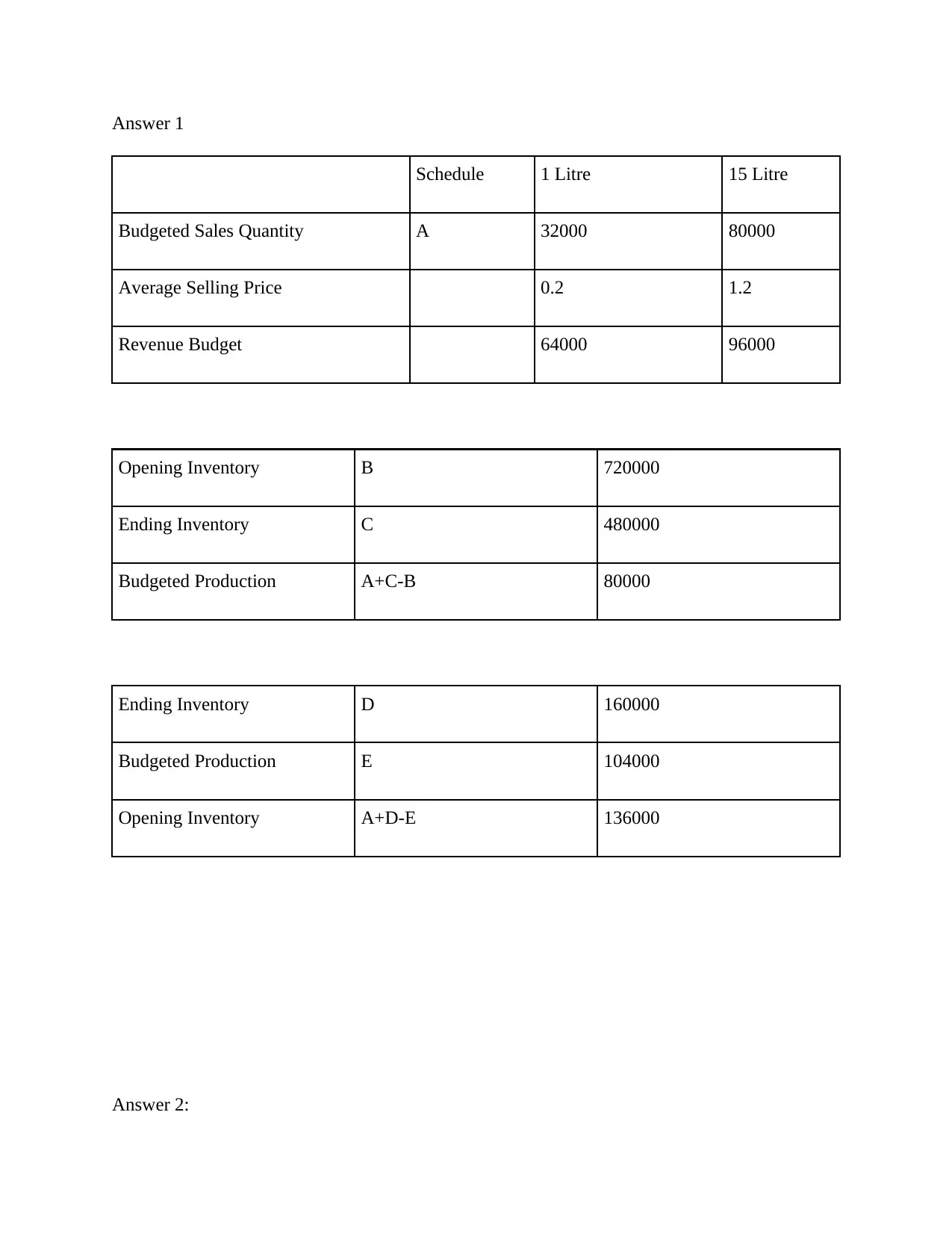
Answer 1
Schedule 1 Litre 15 Litre
Budgeted Sales Quantity A 32000 80000
Average Selling Price 0.2 1.2
Revenue Budget 64000 96000
Opening Inventory B 720000
Ending Inventory C 480000
Budgeted Production A+C-B 80000
Ending Inventory D 160000
Budgeted Production E 104000
Opening Inventory A+D-E 136000
Answer 2:
Schedule 1 Litre 15 Litre
Budgeted Sales Quantity A 32000 80000
Average Selling Price 0.2 1.2
Revenue Budget 64000 96000
Opening Inventory B 720000
Ending Inventory C 480000
Budgeted Production A+C-B 80000
Ending Inventory D 160000
Budgeted Production E 104000
Opening Inventory A+D-E 136000
Answer 2:
Paraphrase This Document
Need a fresh take? Get an instant paraphrase of this document with our AI Paraphraser
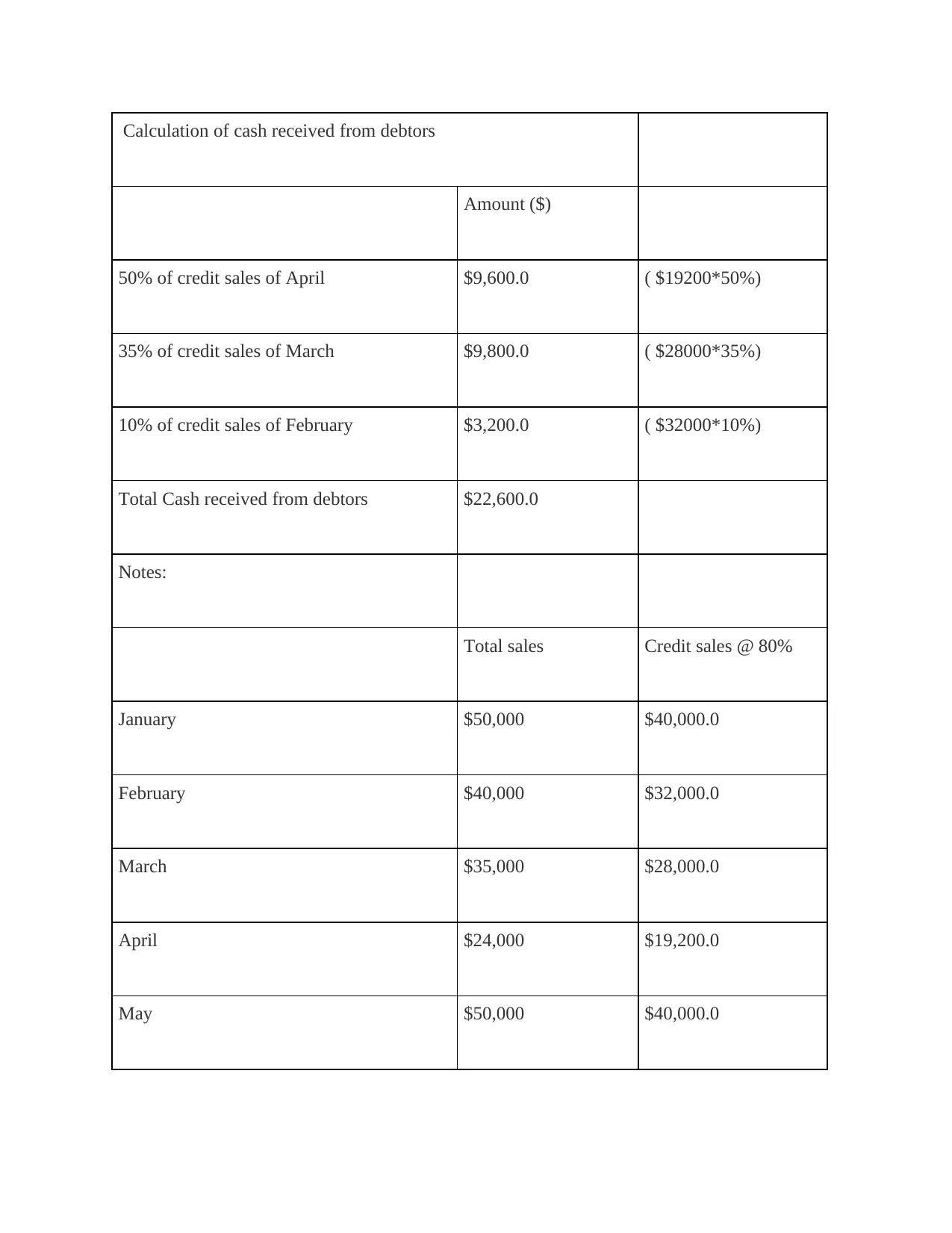
Calculation of cash received from debtors
Amount ($)
50% of credit sales of April $9,600.0 ( $19200*50%)
35% of credit sales of March $9,800.0 ( $28000*35%)
10% of credit sales of February $3,200.0 ( $32000*10%)
Total Cash received from debtors $22,600.0
Notes:
Total sales Credit sales @ 80%
January $50,000 $40,000.0
February $40,000 $32,000.0
March $35,000 $28,000.0
April $24,000 $19,200.0
May $50,000 $40,000.0
Amount ($)
50% of credit sales of April $9,600.0 ( $19200*50%)
35% of credit sales of March $9,800.0 ( $28000*35%)
10% of credit sales of February $3,200.0 ( $32000*10%)
Total Cash received from debtors $22,600.0
Notes:
Total sales Credit sales @ 80%
January $50,000 $40,000.0
February $40,000 $32,000.0
March $35,000 $28,000.0
April $24,000 $19,200.0
May $50,000 $40,000.0
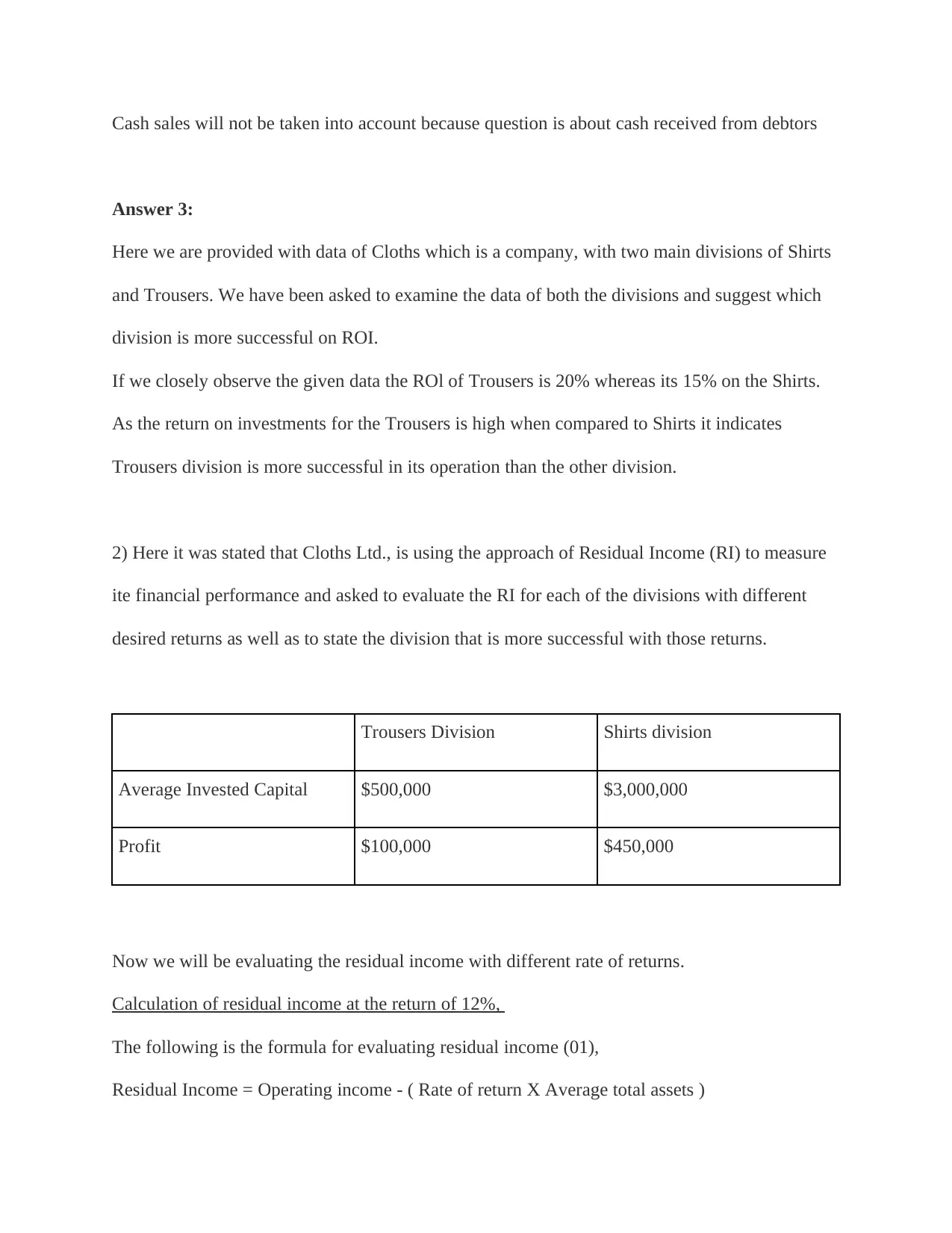
Cash sales will not be taken into account because question is about cash received from debtors
Answer 3:
Here we are provided with data of Cloths which is a company, with two main divisions of Shirts
and Trousers. We have been asked to examine the data of both the divisions and suggest which
division is more successful on ROI.
If we closely observe the given data the ROl of Trousers is 20% whereas its 15% on the Shirts.
As the return on investments for the Trousers is high when compared to Shirts it indicates
Trousers division is more successful in its operation than the other division.
2) Here it was stated that Cloths Ltd., is using the approach of Residual Income (RI) to measure
ite financial performance and asked to evaluate the RI for each of the divisions with different
desired returns as well as to state the division that is more successful with those returns.
Trousers Division Shirts division
Average Invested Capital $500,000 $3,000,000
Profit $100,000 $450,000
Now we will be evaluating the residual income with different rate of returns.
Calculation of residual income at the return of 12%,
The following is the formula for evaluating residual income (01),
Residual Income = Operating income - ( Rate of return X Average total assets )
Answer 3:
Here we are provided with data of Cloths which is a company, with two main divisions of Shirts
and Trousers. We have been asked to examine the data of both the divisions and suggest which
division is more successful on ROI.
If we closely observe the given data the ROl of Trousers is 20% whereas its 15% on the Shirts.
As the return on investments for the Trousers is high when compared to Shirts it indicates
Trousers division is more successful in its operation than the other division.
2) Here it was stated that Cloths Ltd., is using the approach of Residual Income (RI) to measure
ite financial performance and asked to evaluate the RI for each of the divisions with different
desired returns as well as to state the division that is more successful with those returns.
Trousers Division Shirts division
Average Invested Capital $500,000 $3,000,000
Profit $100,000 $450,000
Now we will be evaluating the residual income with different rate of returns.
Calculation of residual income at the return of 12%,
The following is the formula for evaluating residual income (01),
Residual Income = Operating income - ( Rate of return X Average total assets )
You're viewing a preview
Unlock full access by subscribing today!
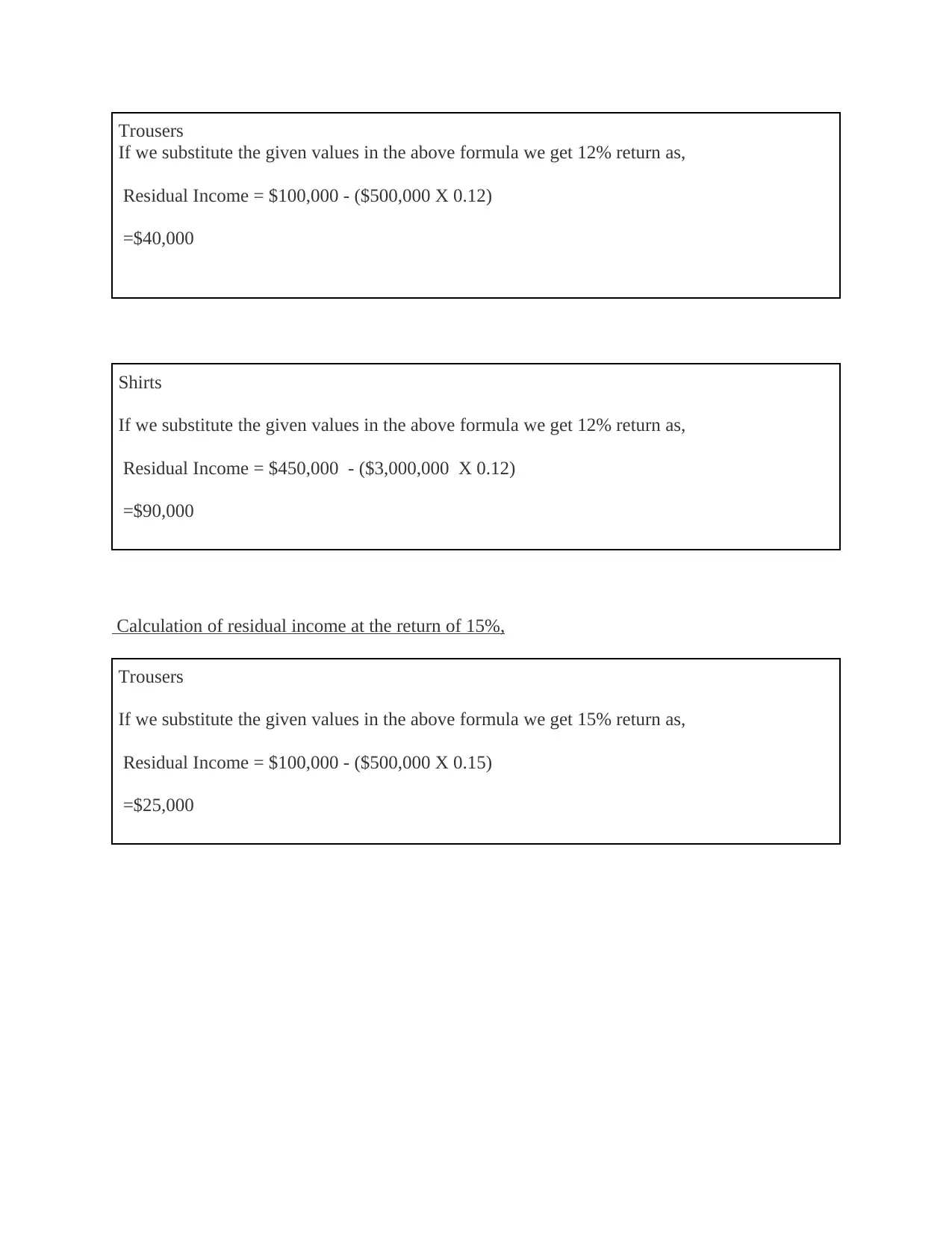
Trousers
If we substitute the given values in the above formula we get 12% return as,
Residual Income = $100,000 - ($500,000 X 0.12)
=$40,000
Shirts
If we substitute the given values in the above formula we get 12% return as,
Residual Income = $450,000 - ($3,000,000 X 0.12)
=$90,000
Calculation of residual income at the return of 15%,
Trousers
If we substitute the given values in the above formula we get 15% return as,
Residual Income = $100,000 - ($500,000 X 0.15)
=$25,000
If we substitute the given values in the above formula we get 12% return as,
Residual Income = $100,000 - ($500,000 X 0.12)
=$40,000
Shirts
If we substitute the given values in the above formula we get 12% return as,
Residual Income = $450,000 - ($3,000,000 X 0.12)
=$90,000
Calculation of residual income at the return of 15%,
Trousers
If we substitute the given values in the above formula we get 15% return as,
Residual Income = $100,000 - ($500,000 X 0.15)
=$25,000
Paraphrase This Document
Need a fresh take? Get an instant paraphrase of this document with our AI Paraphraser
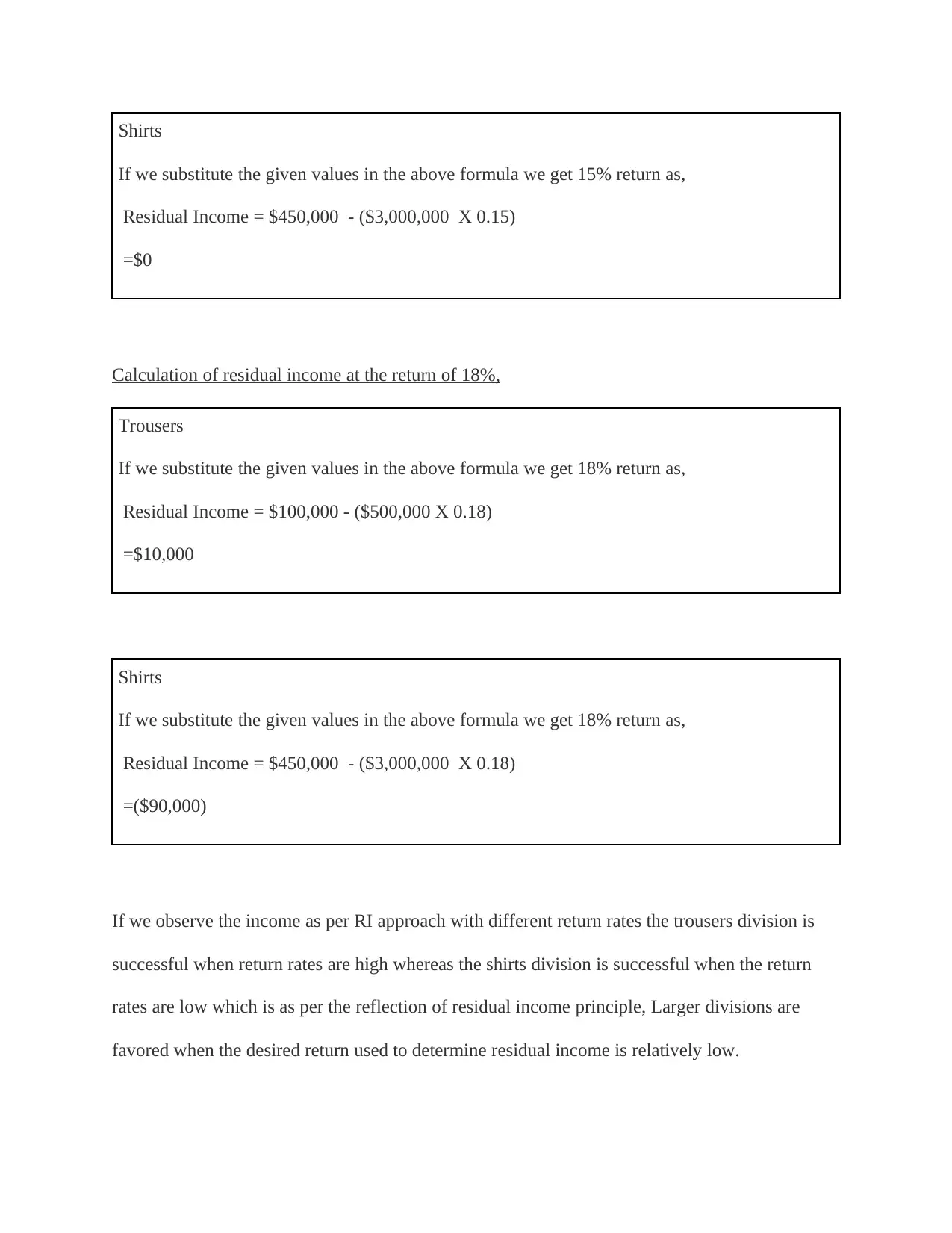
Shirts
If we substitute the given values in the above formula we get 15% return as,
Residual Income = $450,000 - ($3,000,000 X 0.15)
=$0
Calculation of residual income at the return of 18%,
Trousers
If we substitute the given values in the above formula we get 18% return as,
Residual Income = $100,000 - ($500,000 X 0.18)
=$10,000
Shirts
If we substitute the given values in the above formula we get 18% return as,
Residual Income = $450,000 - ($3,000,000 X 0.18)
=($90,000)
If we observe the income as per RI approach with different return rates the trousers division is
successful when return rates are high whereas the shirts division is successful when the return
rates are low which is as per the reflection of residual income principle, Larger divisions are
favored when the desired return used to determine residual income is relatively low.
If we substitute the given values in the above formula we get 15% return as,
Residual Income = $450,000 - ($3,000,000 X 0.15)
=$0
Calculation of residual income at the return of 18%,
Trousers
If we substitute the given values in the above formula we get 18% return as,
Residual Income = $100,000 - ($500,000 X 0.18)
=$10,000
Shirts
If we substitute the given values in the above formula we get 18% return as,
Residual Income = $450,000 - ($3,000,000 X 0.18)
=($90,000)
If we observe the income as per RI approach with different return rates the trousers division is
successful when return rates are high whereas the shirts division is successful when the return
rates are low which is as per the reflection of residual income principle, Larger divisions are
favored when the desired return used to determine residual income is relatively low.
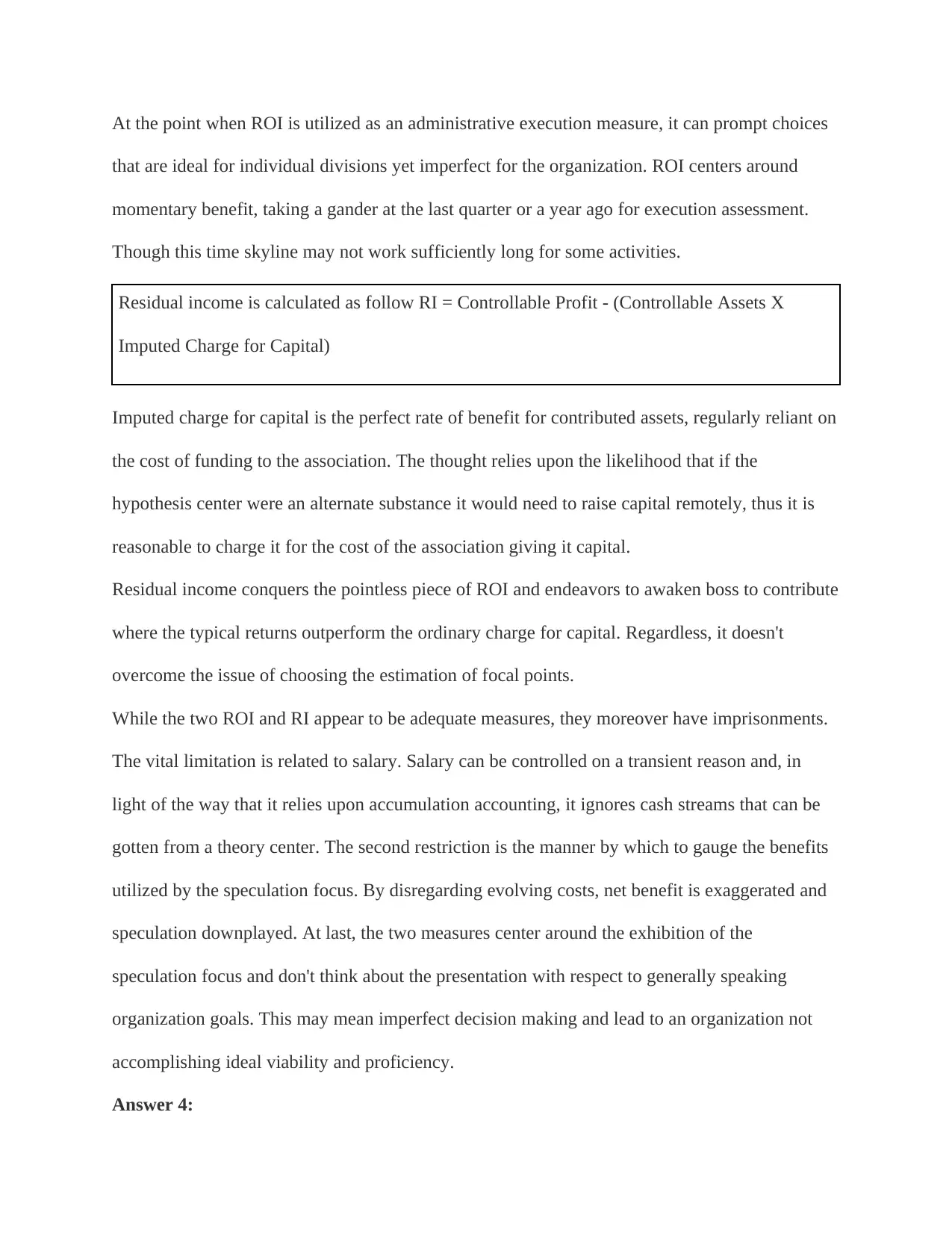
At the point when ROI is utilized as an administrative execution measure, it can prompt choices
that are ideal for individual divisions yet imperfect for the organization. ROI centers around
momentary benefit, taking a gander at the last quarter or a year ago for execution assessment.
Though this time skyline may not work sufficiently long for some activities.
Residual income is calculated as follow RI = Controllable Profit - (Controllable Assets X
Imputed Charge for Capital)
Imputed charge for capital is the perfect rate of benefit for contributed assets, regularly reliant on
the cost of funding to the association. The thought relies upon the likelihood that if the
hypothesis center were an alternate substance it would need to raise capital remotely, thus it is
reasonable to charge it for the cost of the association giving it capital.
Residual income conquers the pointless piece of ROI and endeavors to awaken boss to contribute
where the typical returns outperform the ordinary charge for capital. Regardless, it doesn't
overcome the issue of choosing the estimation of focal points.
While the two ROI and RI appear to be adequate measures, they moreover have imprisonments.
The vital limitation is related to salary. Salary can be controlled on a transient reason and, in
light of the way that it relies upon accumulation accounting, it ignores cash streams that can be
gotten from a theory center. The second restriction is the manner by which to gauge the benefits
utilized by the speculation focus. By disregarding evolving costs, net benefit is exaggerated and
speculation downplayed. At last, the two measures center around the exhibition of the
speculation focus and don't think about the presentation with respect to generally speaking
organization goals. This may mean imperfect decision making and lead to an organization not
accomplishing ideal viability and proficiency.
Answer 4:
that are ideal for individual divisions yet imperfect for the organization. ROI centers around
momentary benefit, taking a gander at the last quarter or a year ago for execution assessment.
Though this time skyline may not work sufficiently long for some activities.
Residual income is calculated as follow RI = Controllable Profit - (Controllable Assets X
Imputed Charge for Capital)
Imputed charge for capital is the perfect rate of benefit for contributed assets, regularly reliant on
the cost of funding to the association. The thought relies upon the likelihood that if the
hypothesis center were an alternate substance it would need to raise capital remotely, thus it is
reasonable to charge it for the cost of the association giving it capital.
Residual income conquers the pointless piece of ROI and endeavors to awaken boss to contribute
where the typical returns outperform the ordinary charge for capital. Regardless, it doesn't
overcome the issue of choosing the estimation of focal points.
While the two ROI and RI appear to be adequate measures, they moreover have imprisonments.
The vital limitation is related to salary. Salary can be controlled on a transient reason and, in
light of the way that it relies upon accumulation accounting, it ignores cash streams that can be
gotten from a theory center. The second restriction is the manner by which to gauge the benefits
utilized by the speculation focus. By disregarding evolving costs, net benefit is exaggerated and
speculation downplayed. At last, the two measures center around the exhibition of the
speculation focus and don't think about the presentation with respect to generally speaking
organization goals. This may mean imperfect decision making and lead to an organization not
accomplishing ideal viability and proficiency.
Answer 4:
You're viewing a preview
Unlock full access by subscribing today!
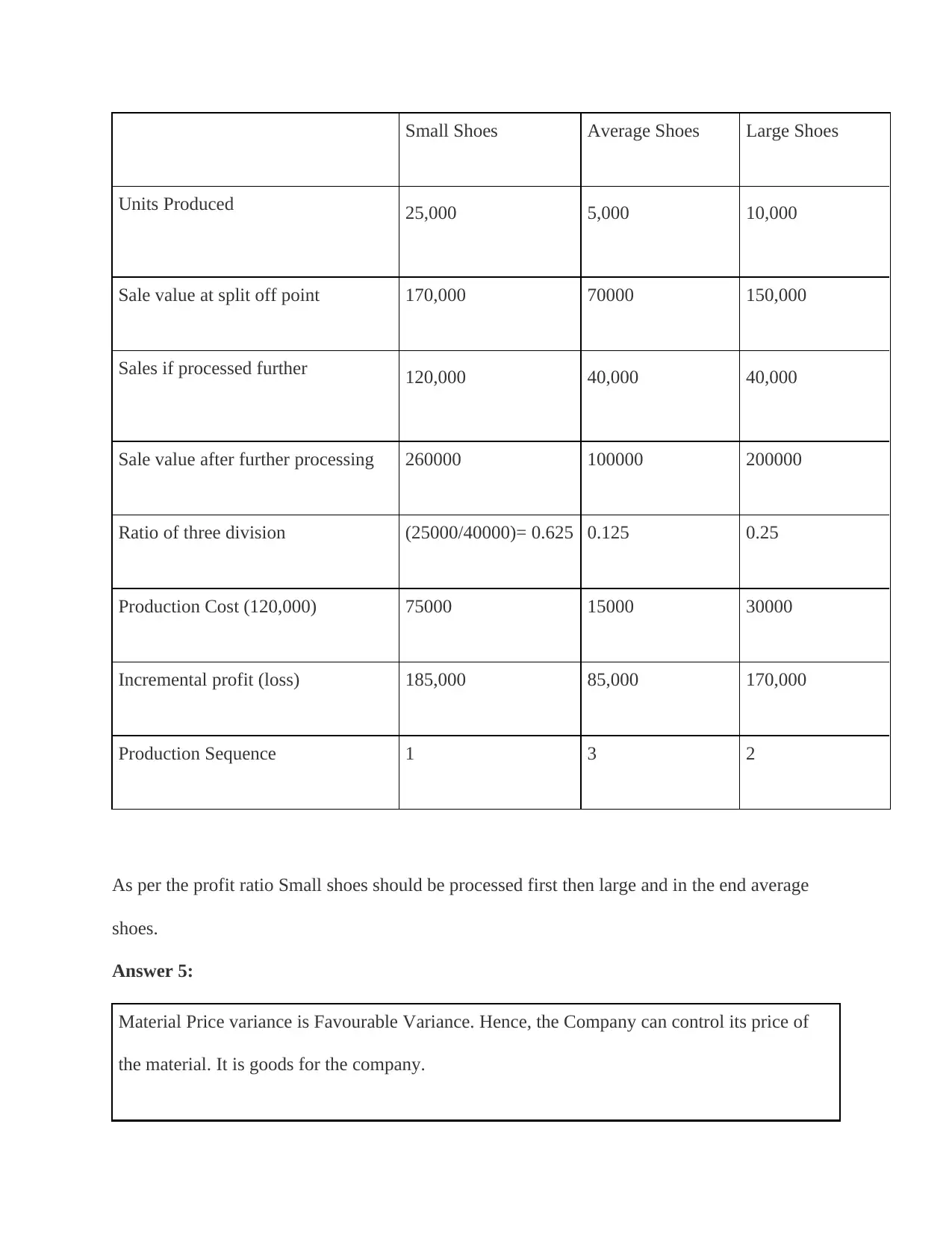
Small Shoes Average Shoes Large Shoes
Units Produced 25,000 5,000 10,000
Sale value at split off point 170,000 70000 150,000
Sales if processed further 120,000 40,000 40,000
Sale value after further processing 260000 100000 200000
Ratio of three division (25000/40000)= 0.625 0.125 0.25
Production Cost (120,000) 75000 15000 30000
Incremental profit (loss) 185,000 85,000 170,000
Production Sequence 1 3 2
As per the profit ratio Small shoes should be processed first then large and in the end average
shoes.
Answer 5:
Material Price variance is Favourable Variance. Hence, the Company can control its price of
the material. It is goods for the company.
Units Produced 25,000 5,000 10,000
Sale value at split off point 170,000 70000 150,000
Sales if processed further 120,000 40,000 40,000
Sale value after further processing 260000 100000 200000
Ratio of three division (25000/40000)= 0.625 0.125 0.25
Production Cost (120,000) 75000 15000 30000
Incremental profit (loss) 185,000 85,000 170,000
Production Sequence 1 3 2
As per the profit ratio Small shoes should be processed first then large and in the end average
shoes.
Answer 5:
Material Price variance is Favourable Variance. Hence, the Company can control its price of
the material. It is goods for the company.
Paraphrase This Document
Need a fresh take? Get an instant paraphrase of this document with our AI Paraphraser
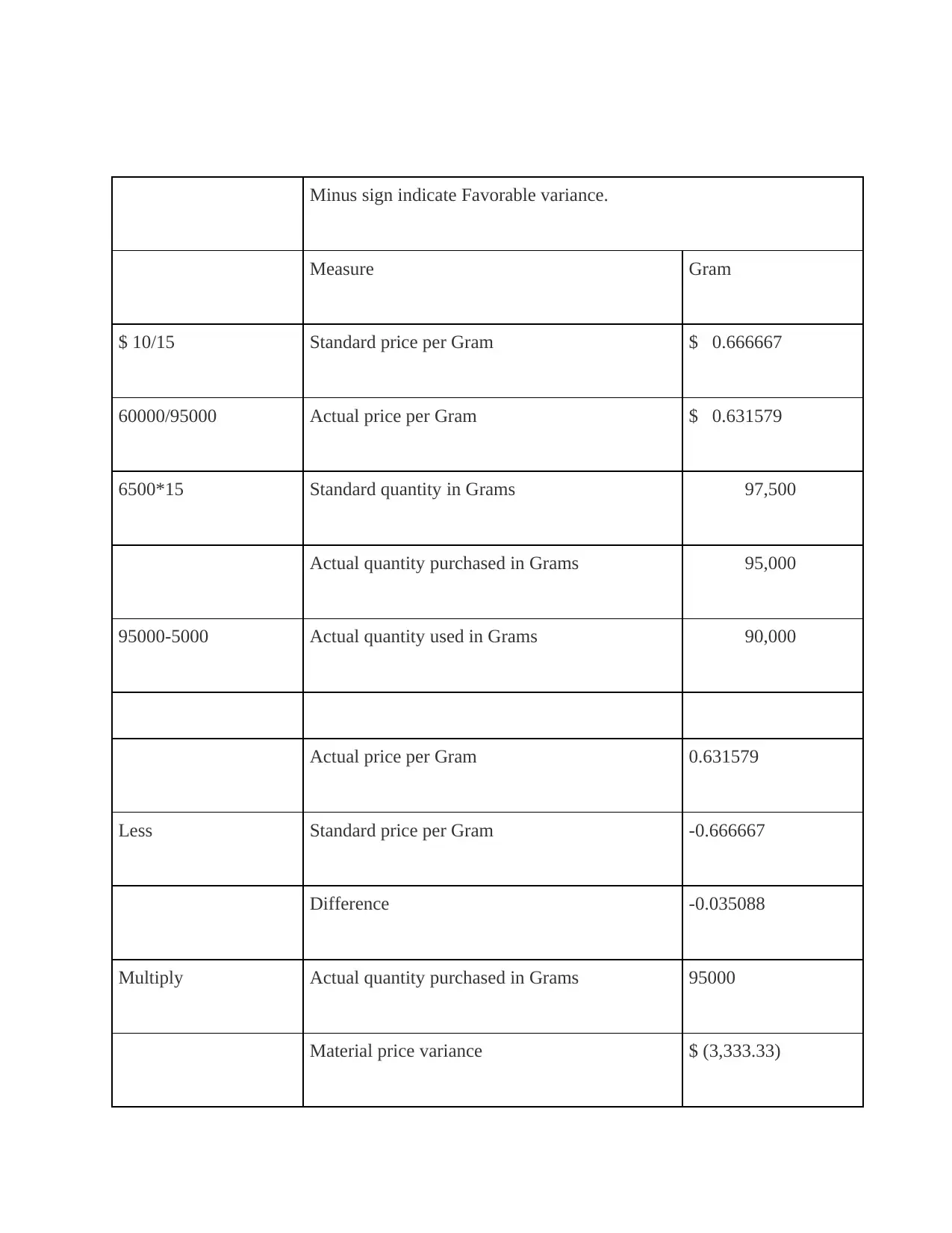
Minus sign indicate Favorable variance.
Measure Gram
$ 10/15 Standard price per Gram $ 0.666667
60000/95000 Actual price per Gram $ 0.631579
6500*15 Standard quantity in Grams 97,500
Actual quantity purchased in Grams 95,000
95000-5000 Actual quantity used in Grams 90,000
Actual price per Gram 0.631579
Less Standard price per Gram -0.666667
Difference -0.035088
Multiply Actual quantity purchased in Grams 95000
Material price variance $ (3,333.33)
Measure Gram
$ 10/15 Standard price per Gram $ 0.666667
60000/95000 Actual price per Gram $ 0.631579
6500*15 Standard quantity in Grams 97,500
Actual quantity purchased in Grams 95,000
95000-5000 Actual quantity used in Grams 90,000
Actual price per Gram 0.631579
Less Standard price per Gram -0.666667
Difference -0.035088
Multiply Actual quantity purchased in Grams 95000
Material price variance $ (3,333.33)
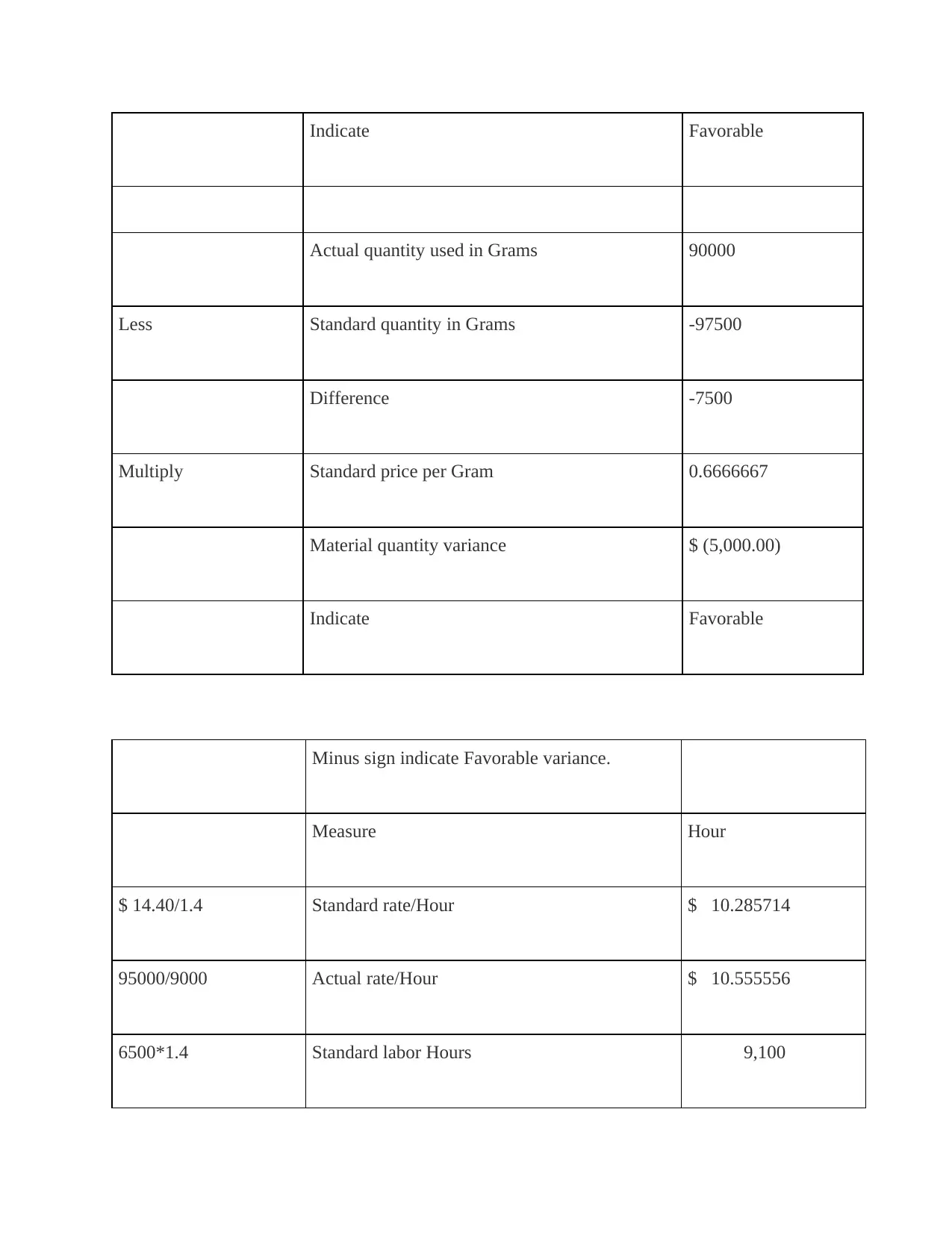
Indicate Favorable
Actual quantity used in Grams 90000
Less Standard quantity in Grams -97500
Difference -7500
Multiply Standard price per Gram 0.6666667
Material quantity variance $ (5,000.00)
Indicate Favorable
Minus sign indicate Favorable variance.
Measure Hour
$ 14.40/1.4 Standard rate/Hour $ 10.285714
95000/9000 Actual rate/Hour $ 10.555556
6500*1.4 Standard labor Hours 9,100
Actual quantity used in Grams 90000
Less Standard quantity in Grams -97500
Difference -7500
Multiply Standard price per Gram 0.6666667
Material quantity variance $ (5,000.00)
Indicate Favorable
Minus sign indicate Favorable variance.
Measure Hour
$ 14.40/1.4 Standard rate/Hour $ 10.285714
95000/9000 Actual rate/Hour $ 10.555556
6500*1.4 Standard labor Hours 9,100
You're viewing a preview
Unlock full access by subscribing today!
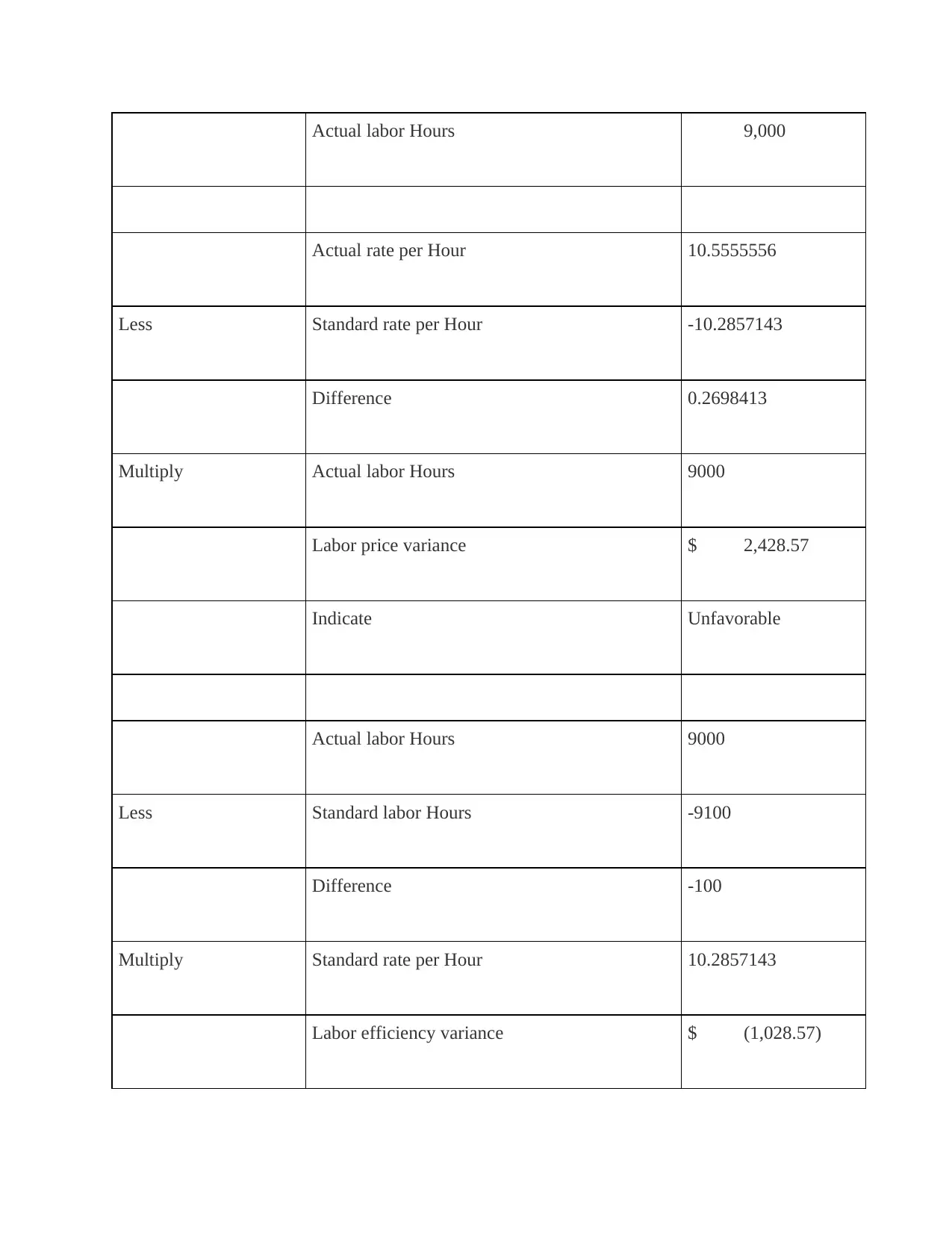
Actual labor Hours 9,000
Actual rate per Hour 10.5555556
Less Standard rate per Hour -10.2857143
Difference 0.2698413
Multiply Actual labor Hours 9000
Labor price variance $ 2,428.57
Indicate Unfavorable
Actual labor Hours 9000
Less Standard labor Hours -9100
Difference -100
Multiply Standard rate per Hour 10.2857143
Labor efficiency variance $ (1,028.57)
Actual rate per Hour 10.5555556
Less Standard rate per Hour -10.2857143
Difference 0.2698413
Multiply Actual labor Hours 9000
Labor price variance $ 2,428.57
Indicate Unfavorable
Actual labor Hours 9000
Less Standard labor Hours -9100
Difference -100
Multiply Standard rate per Hour 10.2857143
Labor efficiency variance $ (1,028.57)
Paraphrase This Document
Need a fresh take? Get an instant paraphrase of this document with our AI Paraphraser
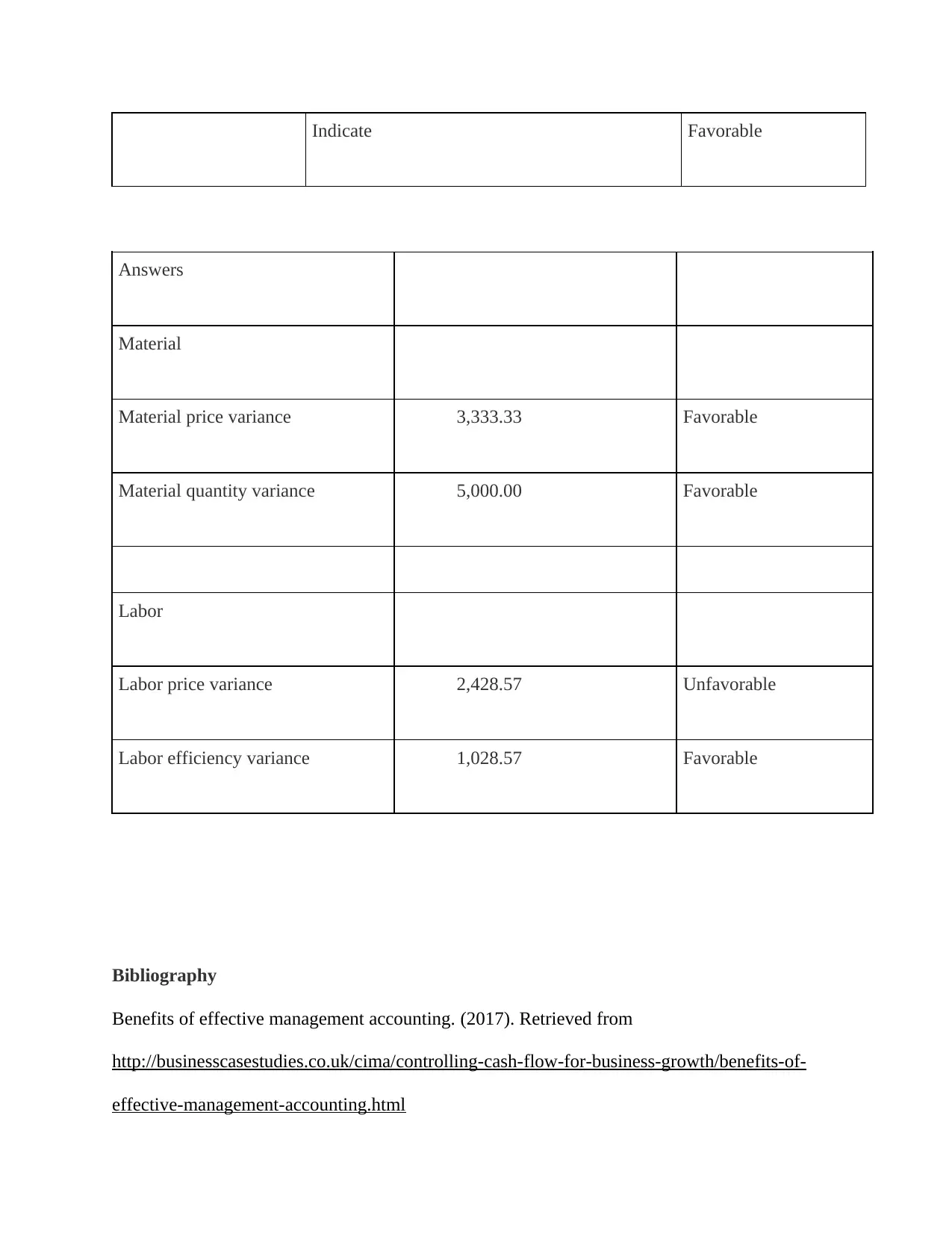
Indicate Favorable
Answers
Material
Material price variance 3,333.33 Favorable
Material quantity variance 5,000.00 Favorable
Labor
Labor price variance 2,428.57 Unfavorable
Labor efficiency variance 1,028.57 Favorable
Bibliography
Benefits of effective management accounting. (2017). Retrieved from
http://businesscasestudies.co.uk/cima/controlling-cash-flow-for-business-growth/benefits-of-
effective-management-accounting.html
Answers
Material
Material price variance 3,333.33 Favorable
Material quantity variance 5,000.00 Favorable
Labor
Labor price variance 2,428.57 Unfavorable
Labor efficiency variance 1,028.57 Favorable
Bibliography
Benefits of effective management accounting. (2017). Retrieved from
http://businesscasestudies.co.uk/cima/controlling-cash-flow-for-business-growth/benefits-of-
effective-management-accounting.html
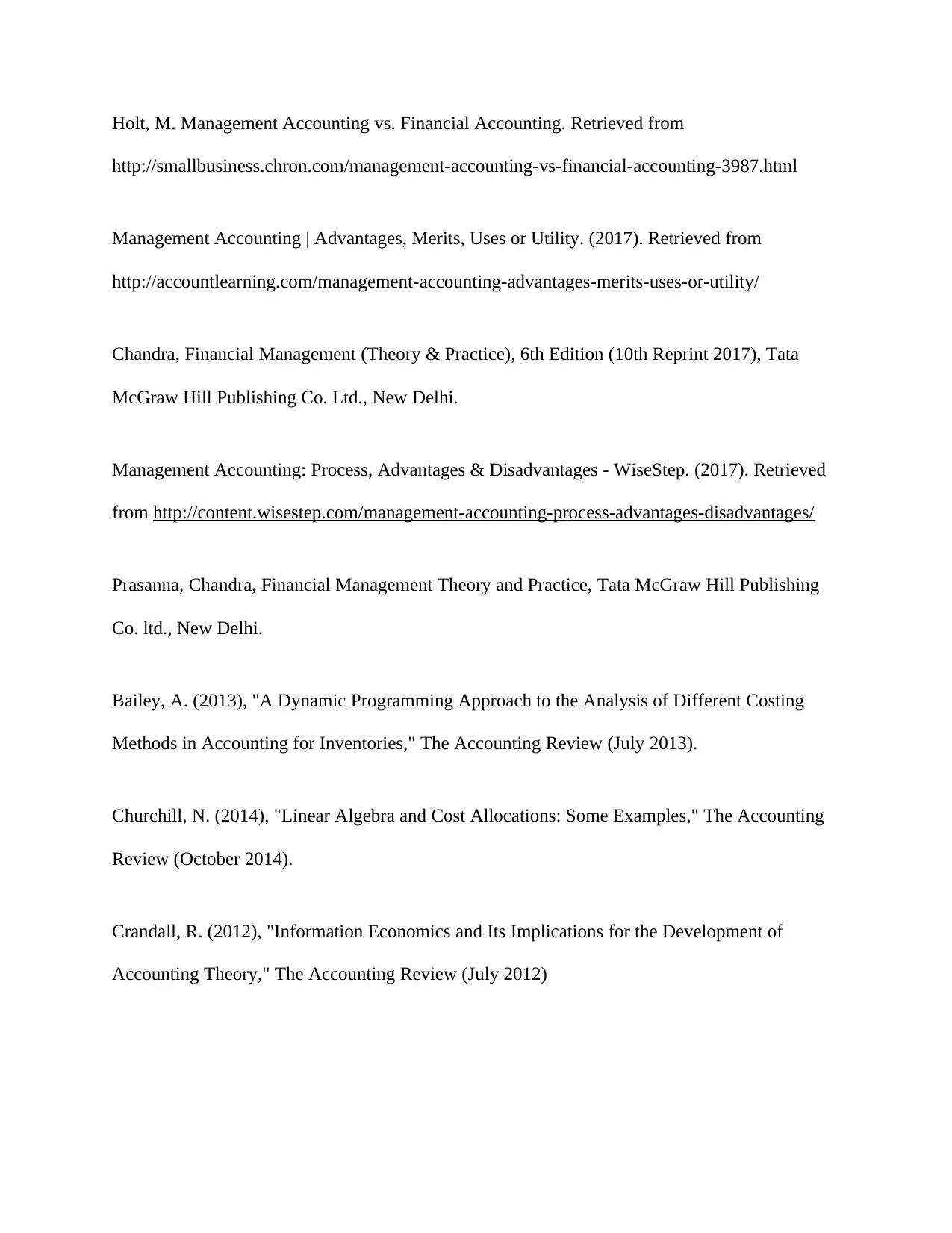
Holt, M. Management Accounting vs. Financial Accounting. Retrieved from
http://smallbusiness.chron.com/management-accounting-vs-financial-accounting-3987.html
Management Accounting | Advantages, Merits, Uses or Utility. (2017). Retrieved from
http://accountlearning.com/management-accounting-advantages-merits-uses-or-utility/
Chandra, Financial Management (Theory & Practice), 6th Edition (10th Reprint 2017), Tata
McGraw Hill Publishing Co. Ltd., New Delhi.
Management Accounting: Process, Advantages & Disadvantages - WiseStep. (2017). Retrieved
from http://content.wisestep.com/management-accounting-process-advantages-disadvantages/
Prasanna, Chandra, Financial Management Theory and Practice, Tata McGraw Hill Publishing
Co. ltd., New Delhi.
Bailey, A. (2013), "A Dynamic Programming Approach to the Analysis of Different Costing
Methods in Accounting for Inventories," The Accounting Review (July 2013).
Churchill, N. (2014), "Linear Algebra and Cost Allocations: Some Examples," The Accounting
Review (October 2014).
Crandall, R. (2012), "Information Economics and Its Implications for the Development of
Accounting Theory," The Accounting Review (July 2012)
http://smallbusiness.chron.com/management-accounting-vs-financial-accounting-3987.html
Management Accounting | Advantages, Merits, Uses or Utility. (2017). Retrieved from
http://accountlearning.com/management-accounting-advantages-merits-uses-or-utility/
Chandra, Financial Management (Theory & Practice), 6th Edition (10th Reprint 2017), Tata
McGraw Hill Publishing Co. Ltd., New Delhi.
Management Accounting: Process, Advantages & Disadvantages - WiseStep. (2017). Retrieved
from http://content.wisestep.com/management-accounting-process-advantages-disadvantages/
Prasanna, Chandra, Financial Management Theory and Practice, Tata McGraw Hill Publishing
Co. ltd., New Delhi.
Bailey, A. (2013), "A Dynamic Programming Approach to the Analysis of Different Costing
Methods in Accounting for Inventories," The Accounting Review (July 2013).
Churchill, N. (2014), "Linear Algebra and Cost Allocations: Some Examples," The Accounting
Review (October 2014).
Crandall, R. (2012), "Information Economics and Its Implications for the Development of
Accounting Theory," The Accounting Review (July 2012)
You're viewing a preview
Unlock full access by subscribing today!
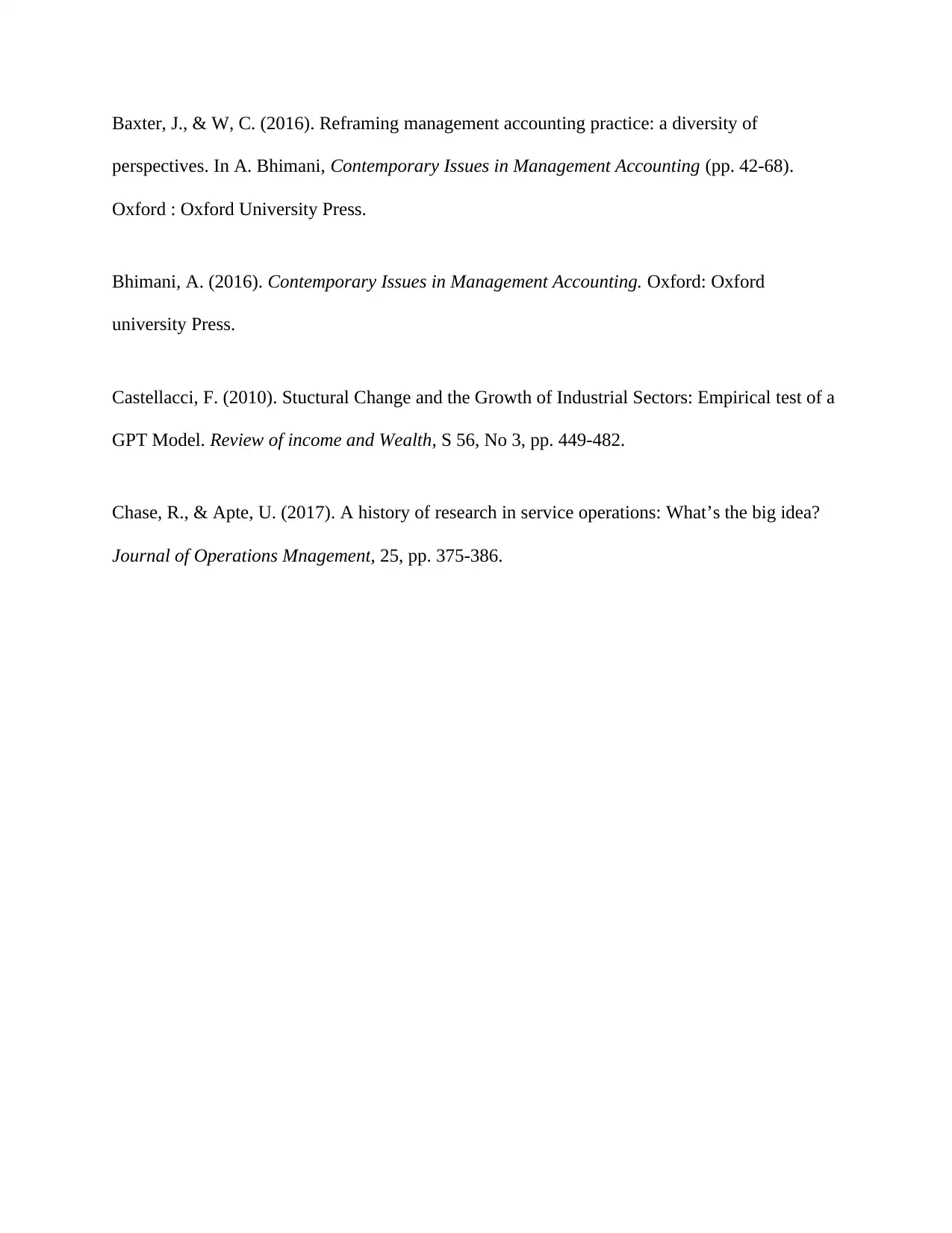
Baxter, J., & W, C. (2016). Reframing management accounting practice: a diversity of
perspectives. In A. Bhimani, Contemporary Issues in Management Accounting (pp. 42-68).
Oxford : Oxford University Press.
Bhimani, A. (2016). Contemporary Issues in Management Accounting. Oxford: Oxford
university Press.
Castellacci, F. (2010). Stuctural Change and the Growth of Industrial Sectors: Empirical test of a
GPT Model. Review of income and Wealth, S 56, No 3, pp. 449-482.
Chase, R., & Apte, U. (2017). A history of research in service operations: What’s the big idea?
Journal of Operations Mnagement, 25, pp. 375-386.
perspectives. In A. Bhimani, Contemporary Issues in Management Accounting (pp. 42-68).
Oxford : Oxford University Press.
Bhimani, A. (2016). Contemporary Issues in Management Accounting. Oxford: Oxford
university Press.
Castellacci, F. (2010). Stuctural Change and the Growth of Industrial Sectors: Empirical test of a
GPT Model. Review of income and Wealth, S 56, No 3, pp. 449-482.
Chase, R., & Apte, U. (2017). A history of research in service operations: What’s the big idea?
Journal of Operations Mnagement, 25, pp. 375-386.
1 out of 13
Your All-in-One AI-Powered Toolkit for Academic Success.
+13062052269
info@desklib.com
Available 24*7 on WhatsApp / Email
![[object Object]](/_next/static/media/star-bottom.7253800d.svg)
Unlock your academic potential
© 2024 | Zucol Services PVT LTD | All rights reserved.
